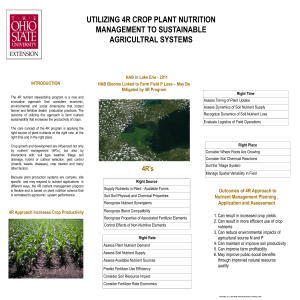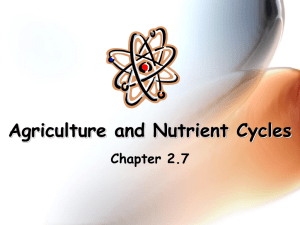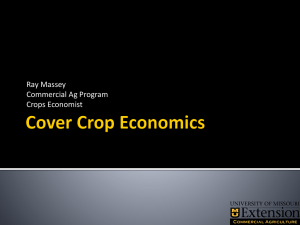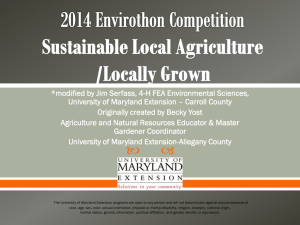Soil Management and Conservation
advertisement
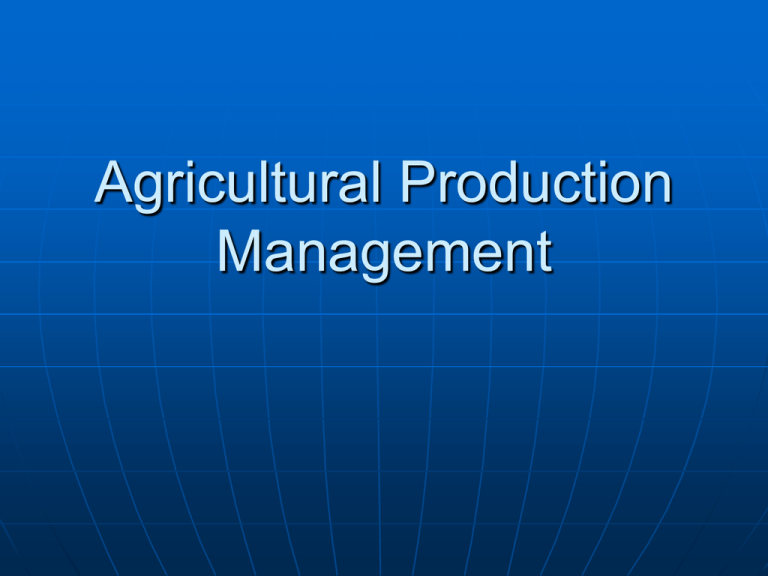
Agricultural Production Management Production Management Categories Classified into four types of Production Management Soil and Crop management Pest management Nutrient management Water management Types of Farming Systems Combination of production management practices employed to achieve production, profit, and increasingly, environmental and sustainability objectives Conventional, high-synthetic-input systems Reduced –synthetic-input systems Cultural practices Biological practices Organic farming systems Types of Farming Systems • • • Other ways of Grouping Systems Cropping systems Tillage systems Irrigation systems Factors Affecting Farmer’s Decisions Management skills Economic factors Environmental pressures Availability of technology and technical support Soil Management and Conservation Importance of Soil As the key resource in crop production It supports the physical, chemical, and biological processes Regulates water flow such as • Infiltration • Root-zone storage • Deep percolation • Run-off Importance of Soil Acts as a buffer between inputs and environment Functions as “degrader” or “immobilizer” of agricultural chemicals, wastes, or other pollutants Soil also sequesters carbon from the atmosphere Important Soil attributes Texture Structure Bulk density and rooting depth Permeability and water storage capacity Carbon content Organic matter and biological activity pH Electrical conductivity Three functions of soil (from NRC) 1. 2. 3. Provides the physical, chemical, and biological processes for the growth of plants To store, regulate, and partition water flow through the environment To buffer environmental change by decomposing organic wastes, nitrates, pesticides, and other substances that could become pollutants Soil Quality Defined: The capacity of soil to function or the fitness for use Can be maintained through use of appropriate crop production technologies and resource management systems Two concepts of measuring soil quality • More traditional: focuses on inherent soil properties • More recent: focuses on dynamic properties of soil Land capability and suitability Two types of measurements: • Land Capability Classes (LCC’s) • Prime farmland designation Used to measure land capabilities for a particular purpose: • Growing crops and trees • Grazing animals • Nonagricultural uses Land Capability Classes (LCC’s) Range from I to VIII: • Class I: no significant limitations for raising crops; About 7% of US cropland • Classes II and III: have some limitations such as poor drainage, limited root zones, climatic restrictions, or erosion potential; make up over ¾ of US cropland Land Capability Classes (LCC’s) • Class IV: suitable only under selected cropping practices • Classes V, VI, and VII: best suited for pasture and range • Class VIII: is only suited for wildlife habitat, recreation, and other nonagricultural uses LCC’s I through III total 337 million acres, or 82% of US cropland excluding Alaska Prime Farmland Based on physical and morphological soil characteristics: • • • • • • • • Depth of water table to the root zone Moisture-holding capacity Degree of salinity Permeability Frequency of flooding Soil temperature Erodibility Soil acidity Prime Farmland Factors needed to sustain high yields when treated and managed • Growing season • Moisture supply • Soil quality Totals 222 million acres, or 54% of US cropland excluding Alaska Productivity Measures output per unit input Often measured as crop yield per acre Can reflect soil degradation if yields decline as soils become degraded and more inputs are used to compensate for decline in soil quality Erodibility Highly erodible lands (HEL) is a soil quality measure that is important to USDA conservation policy USDA uses the erodibility index (EI) to classify erosion potential Erosion Productivity Loss Measure of productivity loss that converts total erosion from tons per acre per year to inches per year 3 factors reflected in this measure: • Erosion rates • Soil depth • Rental values of land Five major concentrations of vulnerable soils Largest: Iowa, Illinois, and Missouri in the corn belt Second: eastern North Dakota and western and south central Minnesota Third: eastern bluffs of Mississippi River in western Kentucky, Tennessee, and along eastern edge of Mississippi Delta Fourth: eastern edge of Colorado Fifth: band of land in eastern Washington and Oregon around Palouse and Central Plateau Effects of erosion Two types: • Onsite effects • Offsite effects Major onsite effect is impact on soil productivity Offsite damages occur when: • Sediment enter the streams, rivers, lakes, and other water bodies and damages municipal water systems • Fills reservoirs and streams interfering with navigation, and contributes to flooding Inappropriate farming practices Lead to: • • • • • • • • Soil degradation Soil erosion Loss of organic matter Soil compaction Acidification Loss of nitrates, phosphates, and pesticides Accumulation of salts and trace elements Increased run-off of fertilizers and pesticides to water systems Soil Degradation 3 Processes • Physical Wind erosion Water erosion Compaction • Chemical Toxification Salinization Acidification • Biological Declines in organic matter Declines in carbon Declines in the activity and diversity of soil fauna Rotational Cropping Can play significant role in conserving soil, maintaining soil fertility, controlling pests, and also helps break up insect and disease cycles Cover Crops Cover crop of small grains, meadow, or hay planted in the fall after harvest of a row crop provides vegetative cover to reduce soil loss, hold nutrients, add organic matter to the soil, and sequester carbon Crop Residue Management (CRM) CRM leaves crop residues on soil surface through less intensive tillage practices. • Usually cost effective • Protects soil surface • Leads to higher farm economic returns Conservation buffers and Structures Structures and buffers reduce water erosion caused by rainfall Very important component of farm soil management systems Pest Management Practices About pesticide One of the first growing agricultural production inputs since the post WW2 $8.8 billions spent in the U.S. in 1997 Herbicides, Insecticides, Fungicides, and Other pesticides Herbicides and insecticides account for most Herbicides Largest pesticide class (62% of total quality of pesticide active ingredients) Weeds compete with crops for water, nutrients, and sunlight, and cause reduced yields. Atrazine,2,4-D, dicamba, and trifluralin are widely used for more than 30 years Insecticides Account for 10 percent of the total quantity of pesticides applied in 1997 Damaging insect populations can vary annually depending on weather, pest cycles, cultural practices such as rotation and destruction of host crop residues Preventive treatments and intervention treatments Insecticides, cont. Corn and cotton account for the largest shares of insecticide use Chlorpyrifos and methyl parathion are the two most widely used insecticides Fungicides Applied to fewer acres than are herbicides and insecticides and account for the smallest shares of total pesticide use Mostly used on fruits and vegetables to control diseases Other pesticides Including soil fumigants, growth regulators, desiccants, and harvest aids Use of these pesticides increases about 8 percent each year since 1990 About one-fifth of the total pounds of all active ingredients applied to the surveyed crops Pesticide Treatment Trends Corn • Corn is the largest crop in the U.S. in terms of acreage • About 30% of the corn acreage in the 10 States received insecticides in 1997 • Corn rootworm was the most frequently treated insect Trends, cont. Soybeans • Herbicides account for virtually all the pesticides used on soybeans • The number of acres treated and number of treatments per acre have increased, partly due to the growth in no-till soybean systems • 48% treated both before and after planting Trends, cont. Wheat • Wheat , which is one of the largest field crops in the U.S. is the least pesticideintensive • Account for 27% of the surveyed crop acreage in 1997, though only 4% of total pesticides • Herbicide used 47%of the winter wheat and 82% of the spring and durum sheats Trends, cont Cotton • One of the most pesticide-intensive field crops in the U.S. • 96% of cotton acreage received herbicides • 74% received insecticides and 68% received other types of pesticides • Much greater insect infestation on cotton is due to its longer growing season Trends, cont. Potatoes • Most pesticide-intensive crops for all types of pesticides Other Vegetable and Fruits • found it profitable to use insecticides and fungicides on a higher percentage of acreage than growers of most field crops do Pesticide Expenditures Annual pesticide expenditures for all farm uses increased from $6.3billion to $8.8 billion over 1991-97 (40% increase) Pesticide costs per acre increased for Corn 20% Cotton 19% Soybeans 25% Wheat 10% Pesticide Resistance Most likely to develop when a pesticide with a single mode of action is used over and over in the absence of any other management measures to control a specific pest Herbicide-resistant weeds Scouting to determine economic thresholds for treatments, alternating the use of pesticide families, and several other management strategies to combat resistance are in use Biological Pest Management Practices Include the use of pheromones, plant regulators, and microbial organisms Biorational pesticides- microbial pesticides and pheromones biologicals are unlikely to replace pesticides in the foreseeable future, due to the small market Beneficial organisms Cultural Pest Management Practice Number of production techniques and practices, including crop rotation, tillage, trap crops, and irrigation scheduling, and such and such Controls work by preventing pest colonization of the crop, reducing pest populations, reducing crop injury, and increasing the number of natural enemies in the cropping system Cultural Pest Management Practice, cont. Crop rotation • One of the most important cultural techniques • 82% of the U.S. corn acreage • 89% of soybeans Cultivation for weed control Field sanitation and water management Decision Criteria and Information Scouting and Economic thresholds • To monitor the populations of major insect and other arthropod pests for several decades • Scouting on 70-90% of grape, orange, apple acreage, and thresholds used on a significant proportion of that acreage Decision Criteria and Information, cont. Sources of pest management information • Farm supply/chemical dealers • consultants’/pest control advisors • Professional scouting services • Extension advisors Decision Criteria and Information, cont. Expert system • Integrate information on pest density, economic thresholds, application methods, and other elements of pest management into a computer software package Precision Farming • Emerging technology that may allow a more efficient application of inputs by using yield monitors, satellite images, etc. Factors Affecting Pest Management Decisions Factors should be influenced by pest infestations, yield and quality losses caused by those infestations, as well as by crop prices and the costs of pesticides and alternative control methods • Changes in planted acres • Weather and other environmental conditions Factors Affecting Pest Management Decisions, cont. Pesticide prices • Increased 17% over 1991-96 • Herbicides 17% increase • Fungicide almost 14% increase • Insecticide about 24% increase Pesticide Regulatory Issues EPA regulates pesticides under the Federal Insecticide Fungicide and Rodenticide Act (FIFRA) Pesticide residues in food under the Federal Food, Drug, and Cosmetic Act (FFDCA) The Clean Air Act, Clean Water Act also contain provisions that affect pesticide manufacturers Pesticide Regulatory Issues, cont. Important regulatory actions • Ex.) Stop selling products containing cyanazine by 1999 Pesticide registration costs • The research and development of a new pesticide averages 11years and cost manufacturers $50-$70 million Regulatory streaming for reducedrisk pesticides Pesticide Regulatory Issues, cont. New pest control products and technology • The EPA registers new pesticides every year • Between 22 and 31 new pesticides per year from 1994 to 1998 are registered Genetically Engineered plants • Seed and chemical companies have expanded research on plant biotechnology because of the increasing costs to develop chemical pesticides Pesticide Regulatory Issues, cont. Genetically engineered plants • Reduces the time required to identify desirable traits • Allows a precise alteration of a plant’s traits • Development of genetically modified plants takes about 6 years and cost about $10 million • U.S. consumer acceptance Alternative Pest Management Programs and Initiatives Integrated pest management (IPM) programs research and promote a combination of cultural, biological and pesticide efficiency tools Areawide pest management systems implements IPM and biological approaches on an areawide basis Alternative Pest Management Programs and Initiatives, cont. Biologically based pest management • Intended to complement IPM programs USDA incentive payments • Environmental Quality Incentives Program (EQIP) provides assistance to eligible farmers and ranchers to address natural resource concerns on their lands in an environmentally beneficial and cost-effective manner Alternative Pest Management Programs and Initiatives, cont. Voluntary environmental standards • Initiated by the private sector • Enforced by firms themselves • Use sanctions such as peer pressure for compliance • Focus on life-cycle impacts • Emphasize management systems Nutrient Use and Management Role of Plant Nutrients Major nutrients: • Nitrogen (N) • Phosphorus (P) • Potassium (K) Other required nutrients: • Magnesium • Calcium • Sulphur Role of Plant Nutrients If no nutrients applied, crops would deplete the soil’s store of nutrients and yields would decline Why manage nutrients? According to the EPA, nutrient pollution is leading cause of water quality impairment in lakes and estuaries and third leading cause in rivers. This usually occurs because of leaching and run-off. Nutrient Sources Commercial fertilizer • Anhydrous ammonia is source of nearly all nitrogen fertilizer • Phosphate fertilizer produced by treating phosphate rock • Potash is used for potassium. Canada supplies US with 95% of their potash Animal manure Transportation costs limits using animal waste as fertilizer Among major field crops share of acres treated with manure: • Corn: 15% • Soybeans: 10% • Wheat: < 3% Municipal and Industrial Wastes Municipal Solid Waste (MSW): • • • • • • • • • • • Paper and paperboard Glass Metals Plastics Rubber Leather Textile Wood Food wastes Yard trimmings And others Municipal and Industrial Wastes Three major methods for MSW disposal • Land filling (61%) • Recoveries for recycle (17%) • Incineration (12%) Commercial fertilizer use Was 7.5 million nutrient tons in 1960 Rose to 23.7 million nutrient tons in 1981 Dropped to 21.3 million nutrient tons in 1995 Rose again to 22 million nutrient tons in 1999 Factors Affecting Fertilizer use Principal factors: • Level and mix of planted cropland • Fertilizer prices • Commodity prices and programs Other factors • • • • • Soil characteristics Climate and weather Crop rotations Application technology Nutrient management practices Nutrient Balance Nutrient mass calculates the residual nitrogen or phosphorus that may remain in the soil or be lost to the environment Categorized as: • High: nutrient input exceeded output in harvested crop by more than 25% • Moderate: nutrient input exceeded output by less than 25% • Negative: total nutrient input was less than the output Nutrient management practices Effective management can help reduce nutrient losses to the environment while sustaining longterm productivity and profitability Includes: • Assessing nutrient needs • Timing nutrient application • Placing nutrients close to crop roots Assessing nutrient needs Improved management requires more information about the nutrients and the use of balances to better assess needs Timing nutrient application Timing applications leaves less nutrients available for loss and can reduce total amount applied Times vary by crop, texture of soil, climate, and stability of the fertilizer Irrigation management Irrigation management is important because: • Too much water promotes leaching, affects nutrient concentration, and affects the rate of nutrient movement • Too little water can stunt plant growth, and reduce crop yield. Improving nutrient management Societies through government can: • Adjust the anticipated costs or benefits of production practices • Regulate certain production practices • Establish markets for animal wastes • Research develop and demonstrate production practices less environmentally damaging


